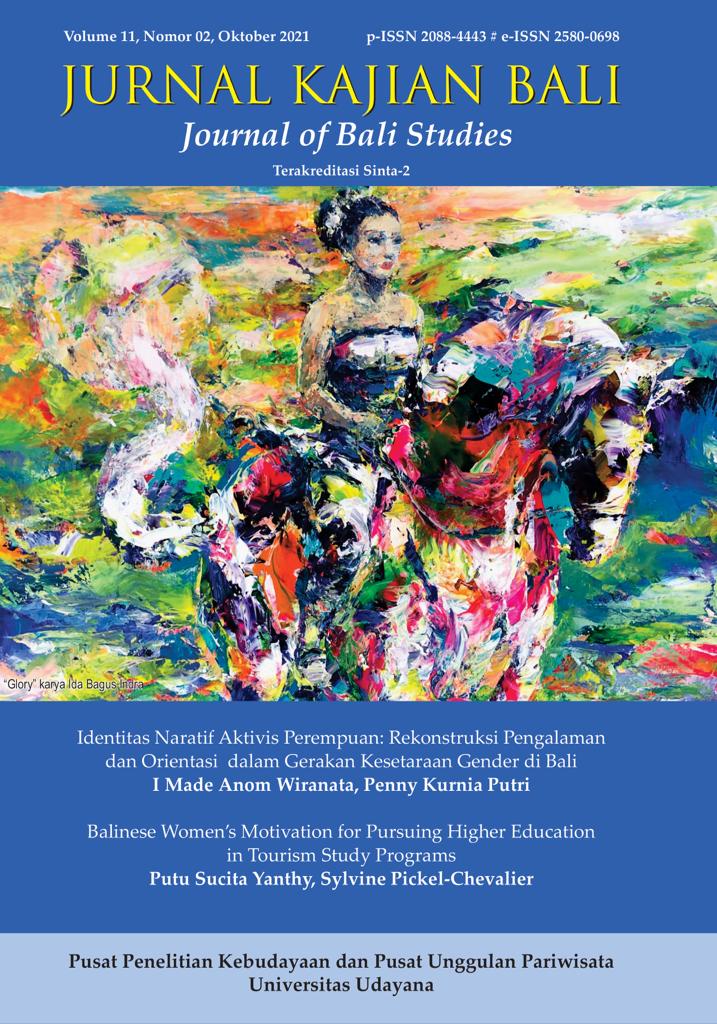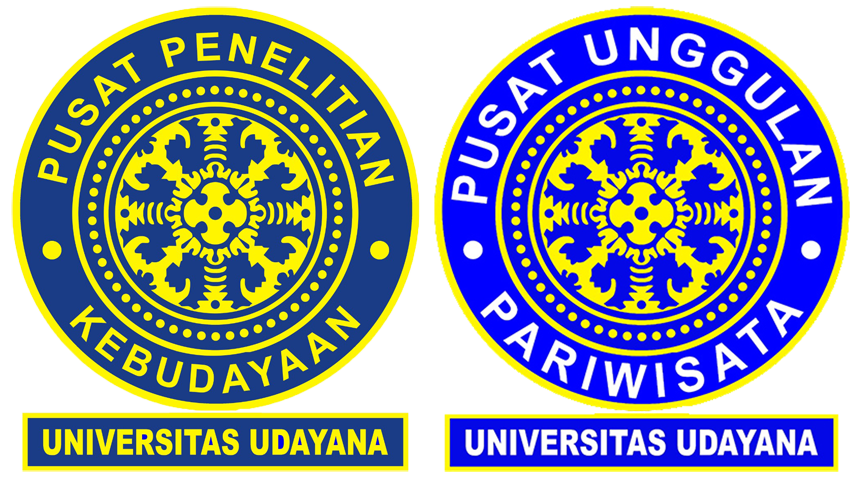Sikap dan Strategi Orang Tua terhadap Pengembangan Kemampuan Multibahasa Anak di Daerah Kuta Bali
Abstract
This study aims to find out Kutanese parents’ attitudes towards Balinese, Indonesian, and Englis, as well as their strategies to develop their children language abilities. Participants in this study were twelve parents. The method for collecting the data was recorded interview and the recordings were then transcribed to facilitate research. The data was analized using family language policy and language strategies theories. Based on the research results, it can be concluded that the participants have very positive attitudes towards Balinese, Indonesian and English. Their positive attitude is also in line with the strategy they are doing, where they want their children to grow up as multilingual children. Of the three languages, English is the language with the most varied strategies.
Downloads
References
Alami, S. A. (2015). “Research within the Field of Applied Linguistics: Points to Consider.” Theory and Practice in Language Studies 5 (7): 1330–37. https://doi.org/10.17507/tpls.0507.03.
Ardiyasa, I Nyoman Suka. (2013). “Catatan Perjuangan Bahasa Bali Dalam Kurikulum 2013.” Jurnal Kajian Bali (Journal of Bali Studies) 2 (2): 1–20.
Beratha, N. L. S. (1999). “Variasi Bahasa Inggris Pada Kawasan Pariwisata Di Bali.” Humaniora 11 (3): 122–31.
Budiana, I Nyoman, and A.A.A.N.T. Rusmini Gorda. (2017). "Peran Desa Adat (Pakraman) dalam Pelestarian Bahasa dan Sastra Dalam Kerangka Penguatan Kebudayaan Bali", Jurnal Ilmiah Dinamika Sosial 1 (2): 108–19.
Byers-Heinlein, Krista, and Casey Lew-Williams. (2013). “Bilingualism in the Early Years: What the Science Says.” LEARNing Landscapes 7 (1): 95–112. https://doi.org/10.36510/learnland.v7i1.632.
Curdt-Christiansen, Xiao Lan. (2009). “Invisible and Visible Language Planning: Ideological Factors in the Family Language Policy of Chinese Immigrant Families in Quebec.” Language Policy 8 (4): 351–75. https://doi.org/10.1007/s10993-009-9146-7.
Dale, Rick, and David W. Vinson. (2013). “The Observer’s Observer’s Paradox.” Journal of Experimental and Theoretical Artificial Intelligence 25 (3): 303–22. https://doi.org/10.1080/0952813X.2013.782987.
Darma, S., and M.S. Siregar. (2017). “Balinese Language Maintenance and Shift among the Third Generation of Balinese Immigrant’s Parents in Kampung Bali Langkat North Sumatera.” International Journal of Language Learning and Applied Linguistic World 16 (1): 1–8.
Djamereng, J. (2014). “Factor of Attitude Contributing to the Maintenance of Balinese Language among Transmigrant Communities in Sukamaju North Luwu.” Research on Humanities and Social Sciences 4 (17): 1–6.
Forey, Gail, Sharon Besser, and Nicholas Sampson. (2016). “Parental Involvement in Foreign Language Learning: The Case of Hong Kong.” Journal of Early Childhood Literacy 16 (3): 383–413. https://doi.org/10.1177/1468798415597469.
Gardner, R. C. (1985). Social Psychology and Second Language Learning: The Role of Attitudes and Motivation. Edited by Howard Giles. London: Edward Arnold.
Goebel, Zane. (2010). Language, Migration, and Identity: Neighborhood Talk in Indonesia. Language, Migration, and Identity: Neighborhood Talk in Indonesia. https://doi.org/10.1017/CBO9780511778247.
Griva, Eleni, and Panagiota Chouvarda. (2012). “Developing Plurilingual Children: Parents’ Beliefs and Attitudes towards English Language Learning and Multilingual Learning.” World Journal of English Language 2 (3). https://doi.org/10.5430/wjel.v2n3p1.
Hardiningsih, S. (2013). “Multilingual Person ’ s Brain Works.” Ragam: Jurnal Pengembangan Humaniora 13 (3): 166–71.
Hosseinpour, Vida, Maryam Sherkatolabbasi, and Mojgann Yarahmadi. (2015). “The Impact of Parents’ Involvement in and Attitude toward Their Children’s Foreign Language Programs for Learning English.” International Journal of Applied Linguistics and English Literature 4 (4): 175–85. https://doi.org/10.7575/aiac.ijalel.v.4n.4p.175.
Imaniah, Ikhfi, Nurul Fitria Kumala Dewi, and Akhmad Zakky. (2020). “Youtube Kids Channels in Developing Young Children’S Communication Skills in English: Parents’ Beliefs, Attitudes, and Behaviors.” Ijlecr - International Journal of Language Education and Culture Review 6 (1): 20–30. https://doi.org/10.21009/ijlecr.061.03.
Kazim Shah, Syed, and Faiza Anwar. (2015). “Attitudes of Parents and Children towards Multilingualism in Pakistan.” Journal of Literature, Languages and Linguistics 8: 22–28. www.iiste.org.
King, Kendall A., Lyn Fogle, and Aubrey Logan-Terry. (2008). “Family Language Policy.” Linguistics and Language Compass 2 (5): 907–22. https://doi.org/10.1111/j.1749-818X.2008.00076.x.
Kocaman, Nurgül, and Orhan Kocaman. (2015). “Parents’ Views Regarding Foreign Language Teaching in Pre-School Institutions.” Turkish Online Journal of Educational Technology 2015 (August): 439–49.
Ladegaard, Hans. J. (2002). “Language Attitudes and Sociolinguistic Behaviour: Exploring Attitude‐ Behaviour Relations in Language.” Journal of Sociolinguistics 4 (2): 214–33.
Makarova, Veronika, Natalia Terekhova, and Amin Mousavi. (2019). “Children’s Language Exposure and Parental Language Attitudes in Russian-as-a-Heritage-Language Acquisition by Bilingual and Multilingual Children in Canada.” International Journal of Bilingualism 23 (2): 457–85. https://doi.org/10.1177/1367006917740058.
Martín, Arancha Ruiz. (2017). “Mixed System 1: A Language Strategy for Bilingual Families.” Elia 17 (July): 125–56. https://doi.org/10.12795/elia.2017.i17.06.
Moleong, Lexy J. (2014). “Metodologi Penelitian Kualitatif.” Bandung: Remaja Rosdakarya 5 (2): 358. https://doi.org/10.21043/thufula.v5i2.3480.
Nishanthi, Rajathurai. (2018). “The Importance of Learning English in Today World.” International Journal of Trend in Scientific Research and Development 3 (1): 871–74. https://doi.org/10.31142/ijtsrd19061.
Pastika, I. (2012). “Pengaruh Bahasa Asing Terhadap Bahasa Indonesia Dan Bahasa Daerah: Peluang Atau Ancaman?” Jurnal Kajian Bali (Journal of Bali Studies) 2 (2): 141–64.
Purnama, I Gede Gita. (n.d.). “Sutindih Ring Basa Bali ; Sinergi Pemerintah Dan Lembaga Non- Pemerintah Dalam Usaha Melestarikan Bahasa Bali.” Kongres Bahasa Indonesia.
Putri, I Gusti Ayu Vina Widiadnya, and I Dewa Ayu Devi Maharani Santika. (2020). “The Emotional Lexicon Used by Male and Female Communication: Study of Balinese Language Used in South Kuta-Bali.” Linguistic, English Education and Art (LEEA) Journal 3 (2): 364–72. https://doi.org/10.31539/leea.v3i2.1177.
Rasyid, Harun. (2017). “Persepsi Orang Tua Dan Guru Mengenai Bahasa Inggris Pada Anak Usia Dini Di Tk ABA Karangmalang Yogyakarta” 6 (2): 29–39.
Rinaldi, Indra, and Yam Saroh. (2017). “THE RISE OF NATIONAL PLUS SCHOOL IN INDONESIA – EDUCATION FOR PARENTS AND GOVERNMENT.” Lingua Didaktika Jurnal Bahasa Dan Pembelajaran Bahasa 10 (2): 194.
Santosa, Arif Ismail, Zainal Rafli, and Ninuk Lustyantie. (2018). “Pengaruh Pola Asuh Orang Tua Dan Sikap Bahasa Terhadap Kemampuan Membaca Pemahaman The Influence of Parenting Style and Language Attitude toward the Reading Comprehension Achievement.” Jurnal Pendidikan Bahasa Dan Sastra 18 (April): 69–80.
Sari, Meliana. (2018). “Peran Orang Tua Dalam Menstimulai Perkembangan Bahasa Anak Usia Dini.” Jurnal Pendidikan Dan Perkembangan Anak I (2): 37–46.
Seri Malini, Ni Luh Nyoman, Ni Luh Putu Laksminy, and I Nengah Ketut Sulibra. (2018). “Pilihan Bahasa Generasi Muda Di Destinasi Wisata Di Bali.” Jurnal Kajian Bali (Journal of Bali Studies) 8 (1): 71. https://doi.org/10.24843/JKB.2018.v08.i01.p05.
Setyowati, Rr. Nanik dan Alfian Susanti. (2015). “Strategi Orang Tua Dalam Mendidik Perilaku Berkarakter Anak Usia Dini Di Desa Balongmasin Kecamatan Pungging Kabupaten Mojokerto.” Kajian Moral Dan Kewarganegaraan 2 (3): 575–90.
Spolsky, Bernard. (2009). Language Management. Language Management. https://doi.org/10.1017/CBO9780511626470.
Suastra, I Made. (2009). “Bahasa Bali Sebagai Simbol Identitas Manusia Bali.” Linguistika 16 (March).
Sugiyono. (2014). “Metode Penelitian Pendidikan (Pendidikan Kuantitaif, Kealitatif, Dan R & D).” Bandung: Penerbit Alfabeta 2 (1): 83–108.
Sukarelawanto, E. (2018). “Bahasa Asing Dominasi Ruang Publik Di Destinasi Wisata Bali.” Bisnis.Com. 2018.
Tati, A. D. R. (2015). “Kurikulum Pendidikan Di SD Dan SMA Pada Masa Orde Baru.” Pendidikan Sejarah 4 (2): 89–102.
UNESCO. (2020). “Making Indonesian Indigenous Language Scripts Available Online.” 2020.
Wati, Shafrida. (2016). “Parental Involvement and English Language Teaching to Young.” Prosiding ICCT 1: 527–33.
Xuesong, Gao. (2006). “Strategies Used by Chinese Parents to Support English Language Learning: Voices of ‘Elite’ University Students.” RELC Journal 37 (3): 285–98. https://doi.org/10.1177/0033688206071302.

This work is licensed under a Creative Commons Attribution 4.0 International License.



















